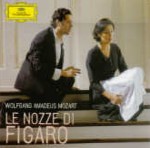I fear that I’ll grow accustomed to the directorial fad designed to rip all the delight out of the Mozart/da Ponte operas, but I’m not pleased about it. Patrice Chereau’s gloom-inducing Cosi from a couple of years ago at Aix (available on Virgin) and Martin Kusej’s recent hell-is-white-with-underwear interpretation of Don Giovanni from Salzburg (on Decca) are just two of the current crop. When the singing is bad as well, such as in the Don Giovanni, it makes ignoring the poet’s and composer’s intentions part of a package of shrugging and saying “that’s life.” But now we get a mostly very well sung Figaro, also from Salzburg, as filtered through a type of Ingmar Bergman-esque lens of fatality and stasis, with bits of rage thrown in, and it saddens me that the singers don’t have anything better to work with. Say what you will–Mozart’s music is, to use the old cliché, life-affirming; but both director Claus Guth and conductor Nikolaus Harnoncourt offer us a metaphorically, physically, and musically drab, unappealing world, and it isn’t fair to the work.
Guth’s only lighthearted touch is the use of a double for Cherubino, a young mute actor in black with small wings who interacts with the other characters. This Cupid figure, called Cherub in the credits, races around, occasionally teasing, occasionally pummeling someone–he caresses Figaro during “Se vuol ballare” and drags the Count around the stage and tears off his shirt during “Vedro mentr’io sospiro”. It is probably Cupid’s presence that instigates so much kissing and fondling in this production: both Susanna and the Countess practically molest Cherubino in the second act. It’s a bit much, but it does no harm.
Glumness is everywhere. Set on the staircase and landings of an empty house sorely in need of painting and scraping in what may be the early 20th century, everyone is in black, white, and grays (sets and costumes are by Christian Schmidt). The lack of furniture assures us that the characters will be on the floor a great deal–and they are. Near the start of the opera Figaro finds a dead crow or raven and tosses it out of the window–a bad sign, I think you’ll agree. When he’s dressing Cherubino and telling him what to expect in the army during “Non piu andrai” he’s in a rage, and abetted by the Count he cuts Cherubino’s hair off and then slashes his arm, rubbing the blood on the boy’s face. It’s a dreadful moment, but is arguably an ideal ending to an act that begins with a dead bird.
In addition, it’s made clear that Susanna and the Count are in fact having an affair, which is sour and makes the Countess-Susanna friendship hypocritical. Oh yes–Bartolo is decrepit, nasty, and in a wheelchair and Don Curzio is blind. Is this colorless, joyless show the Figaro we know? Would Mozart and/or da Ponte feel that their mission had been accomplished?
Conductor Harnoncourt is clearly in complete agreement with Guth and Schmidt. The main continuo instrument is a cello, and so there’s a darkish sound rather than a tinkle under the recitatives. The overture takes a full five minutes; only Böhm (in my CD collection of nine performances) is slower, but his overall performance is 15 minutes faster. In fact, tempos are sometimes outrageously slow, and during Figaro’s and Susanna’s first-act duets Harnoncourt stops the orchestra completely and pauses for the “ding ding” and “dong dong” to absolutely no dramatic effect. The finales get weighed down by the sluggish tempos, with the characters having to move very slowly in order to make any sense of the music.
It isn’t just that the performance is devoid of laughter; it’s an anti-comedy. You realize that when Susanna’s “Deh vieni…” is taken faster than usual it is an anti-romance statement; we mustn’t linger over moments of expected joy. The opera takes three-and-a-quarter hours to get through and has all the sparkle of Pfitzner’s Palestrina.
Within this framework, you can only congratulate the singers. Bo Skovhus’ Count is a sweaty, nervous, angry cheat, and he portrays it ideally, with big, gruff voice and movements. Whether you like anything about him–and forgive him–is another story. Ildebrando d’Arcangelo’s Figaro, looking distraught, face covered by hands as the curtain rises, is superb under the circumstances and he jumps the beat often enough to make clear what his tempo preferences are. He’s sexy and uses his beautiful voice to great dramatic effect.
Anna Netrebko, also looking put-upon from the start, is a darker-toned than usual Susanna, and she’s musical and glamorous–but again, it’s an introspective, mirthless performance. The Countess, as sung by the magnificent Dorothea Röschmann, is less elegant than we usually encounter; I’ve always found Kiri Te Kanawa a bit aloof, but I far prefer her reading of the part. Christine Schäfer’s Cherubino is simply terrific; Franz-Josef Selig comes across as Schigolch in Lulu–hardly a recommendation. The others sing well but are stuck in the directorial and Harnoncourtean mire. The Vienna Philharmonic’s playing is ravishing throughout and at such slow speeds that Harnoncourt gets great detail from the players, particularly the winds. The High Definition picture is spectacular as are the sonics. Subtitles in all major European languages and Chinese.
Is it too much to ask for a balanced view of this opera? Perhaps not a rollicking comedic approach–it isn’t meant to be–but it certainly isn’t an existential Hell either. An old film directed by Jean-Pierre Ponnelle with a stellar cast (Prey, Fischer-Dieskau, Freni, et al, and Böhm) is not a laugh riot either, but it’s thoroughly Mozartean, as this show is not. And the DVD led by John Eliot Gardiner is superb, with Bryn Terfel a knockout. Find them and enjoy Le nozze di Figaro. This one is penance.
































